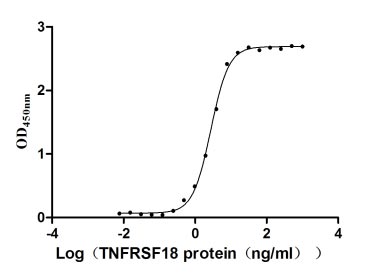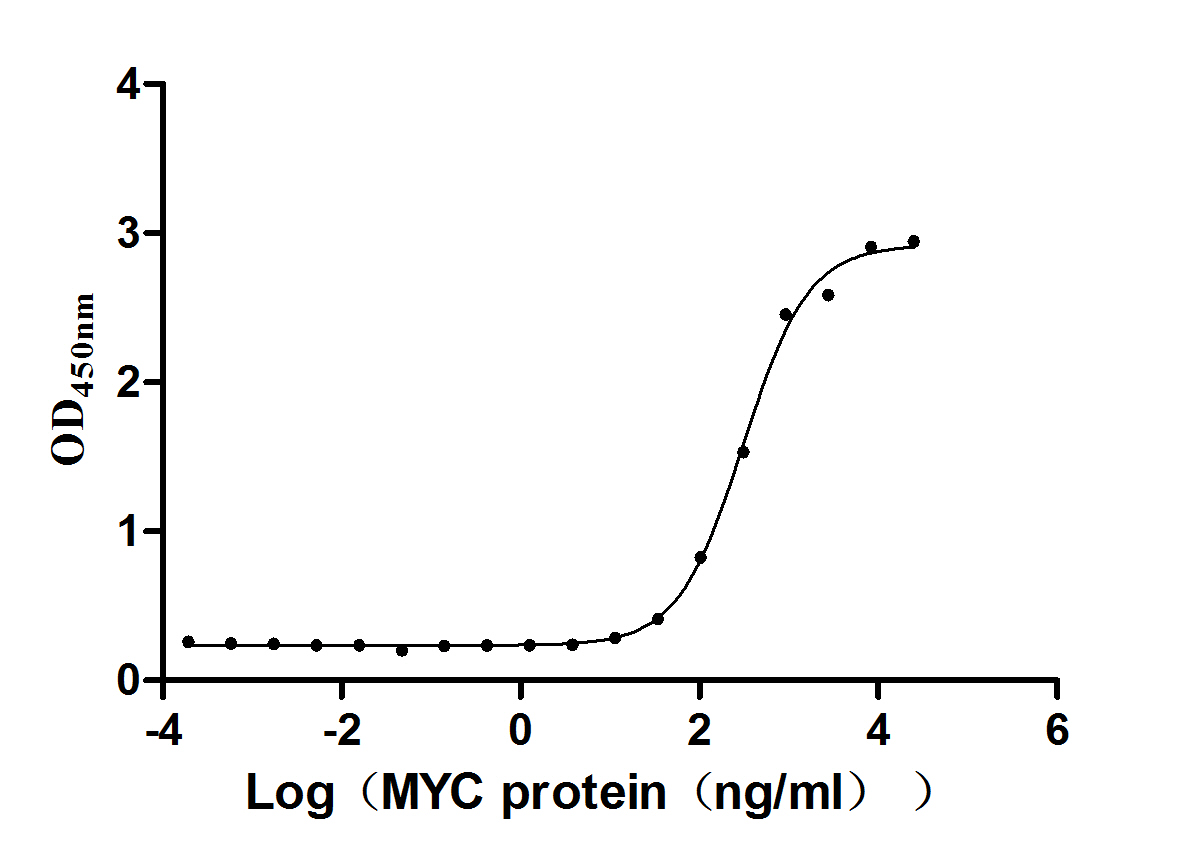Recombinant Mouse ETS translocation variant 4 (Etv4)
-
中文名称:小鼠Etv4重组蛋白
-
货号:CSB-YP007858MO
-
规格:
-
来源:Yeast
-
其他:
-
中文名称:小鼠Etv4重组蛋白
-
货号:CSB-EP007858MO
-
规格:
-
来源:E.coli
-
其他:
-
中文名称:小鼠Etv4重组蛋白
-
货号:CSB-EP007858MO-B
-
规格:
-
来源:E.coli
-
共轭:Avi-tag Biotinylated
E. coli biotin ligase (BirA) is highly specific in covalently attaching biotin to the 15 amino acid AviTag peptide. This recombinant protein was biotinylated in vivo by AviTag-BirA technology, which method is BriA catalyzes amide linkage between the biotin and the specific lysine of the AviTag.
-
其他:
-
中文名称:小鼠Etv4重组蛋白
-
货号:CSB-BP007858MO
-
规格:
-
来源:Baculovirus
-
其他:
-
中文名称:小鼠Etv4重组蛋白
-
货号:CSB-MP007858MO
-
规格:
-
来源:Mammalian cell
-
其他:
产品详情
-
纯度:>85% (SDS-PAGE)
-
基因名:Etv4
-
Uniprot No.:
-
别名:Etv4; Pea-3; Pea3ETS translocation variant 4; Polyomavirus enhancer activator 3; Protein PEA3
-
种属:Mus musculus (Mouse)
-
蛋白长度:Full length protein
-
表达区域:1-485
-
氨基酸序列MERRMKGGYL DQRVPYTFCS KSPGNGSLGE ALMVPQGKLM DPGSLPPSDS EDLFQDLSHF QETWLAEAQV PDSDEQFVPD FHSENSFHSP TTRIKKEPQS PRTDPALSCS RKPPLPYHHG EQCLYSSAYD SPRQIAIKSP APGAPGQSPL QPFSRAEQQQ SLLRASSSSQ SHPGHGYLGE HSSVFQQPVD MCHSFTSPQG GGREPLPAPY QHQLSEPCPP YPQQNFKQEY HDPLYEQAGQ PASSQGGVSG HRYPGAGVVI KQERTDFAYD SDVPGCASMY LHPEGFSGPS PGDGVMGYGY EKSLRPFPDD VCIVPEKFEG DIKQEGIGAF REGPPYQRRG ALQLWQFLVA LLDDPTNAHF IAWTGRGMEF KLIEPEEVAR LWGIQKNRPA MNYDKLSRSL RYYYEKGIMQ KVAGERYVYK FVCEPEALFS LAFPDNQRPA LKAEFDRPVS EEDTVPLSHL DESPAYLPEL TGPAPPFGHR GGYSY
-
蛋白标签:Tag type will be determined during the manufacturing process.
The tag type will be determined during production process. If you have specified tag type, please tell us and we will develop the specified tag preferentially. -
产品提供形式:Lyophilized powder
Note: We will preferentially ship the format that we have in stock, however, if you have any special requirement for the format, please remark your requirement when placing the order, we will prepare according to your demand. -
复溶:We recommend that this vial be briefly centrifuged prior to opening to bring the contents to the bottom. Please reconstitute protein in deionized sterile water to a concentration of 0.1-1.0 mg/mL.We recommend to add 5-50% of glycerol (final concentration) and aliquot for long-term storage at -20℃/-80℃. Our default final concentration of glycerol is 50%. Customers could use it as reference.
-
储存条件:Store at -20°C/-80°C upon receipt, aliquoting is necessary for mutiple use. Avoid repeated freeze-thaw cycles.
-
保质期:The shelf life is related to many factors, storage state, buffer ingredients, storage temperature and the stability of the protein itself.
Generally, the shelf life of liquid form is 6 months at -20°C/-80°C. The shelf life of lyophilized form is 12 months at -20°C/-80°C. -
货期:Delivery time may differ from different purchasing way or location, please kindly consult your local distributors for specific delivery time.Note: All of our proteins are default shipped with normal blue ice packs, if you request to ship with dry ice, please communicate with us in advance and extra fees will be charged.
-
注意事项:Repeated freezing and thawing is not recommended. Store working aliquots at 4°C for up to one week.
-
Datasheet :Please contact us to get it.
靶点详情
-
功能:Transcriptional activator. May play a role in keratinocyte differentiation.
-
基因功能参考文献:
- This study demonstrates that Etv4 and Etv5 transcription factors are expressed in hippocampal pyramidal neurons during the main period of dendritogenesis; reveals a novel role for Etv4 and Etv5 transcription factors for hippocampal circuit development and the coordination of synaptic maturation; and indicates that both factors are essential in the transcriptional program linking BDNF signaling to dendrite development. PMID: 27909004
- The E26 transformation-specific transcription factor, ETV4, which is induced by fibroblast growth factor signalling and acts as a repressor of ZRS activity, interacts with the histone deacetylase HDAC2 and ensures that the poised ZRS remains transcriptionally inactive. PMID: 28949289
- Our results will help understand the mechanism of ETV4 overexpression in CRC patients and provide a clue to search new therapeutic target to treat the related tumors in clinical practice. PMID: 28373072
- ETS-related transcription factors ETV4 and ETV5 are involved in proliferation and induction of differentiation-associated genes in embryonic stem (ES) cells. PMID: 26224636
- paracrine signaling via fibroblast growth factor 2 (Fgf2) and Mapk between these diverged tumor subclones causes enhanced expression of the Pea3 transcription factor, resulting in metastatic dissemination of the neuroendocrine tumor subclones. PMID: 26215568
- Study hypothesized that PEA3 might play an essential role in the activation of the FAK gene during tumor metastasis. PMID: 24260201
- Study reveals molecular insight into how the Ets family transcription factor Pea3 favors EMT and contributes to tumorigenesis via a negative regulatory loop with Cyclin D2, a new Pea3 target gene. PMID: 23989931
- PEA3-null fibroblasts exhibit impaired c-src activation and motility defects. PMID: 22982417
- study provides evidence for a protumorigenic role of PEA3 factors in breast neoplasia, and supports targeting the PEA3 transcription factor family in breast cancer PMID: 20107508
- Induction of Pea3 gene expression by peripheral signals is required to coordinate the central position and terminal arborization of specific sets of spinal motor neurons. PMID: 12372283
- PEA3 expression in developing motor neurons is regulated by GDNF signals from the limb bud. PMID: 12372284
- motoneurons innervating the cutaneous maximus muscle, which are normally PEA3(+), fail to develop normally so that postnatally the muscle is innervated by few motoneurons and is severely atrophic PMID: 12527001
- Pea3 is expressed in tissues undergoing branching morphogenesis and promotes formation of duct-like structures by mammary epithelial cells in vitro. PMID: 12871699
- Pea3 subfamily members play a role in epithelial-mesenchymal interactions during lung organogenesis. PMID: 12941618
- pea3 is induced by GDNF in a subset of the motor neurons. Signaling by the HGF receptor (met), is required for rostral expansion of the pea3 domain, while pea3 expression is independent of met function. PMID: 12948444
- Beta-catenin, Lef-1, Ets transcription factors, and the AP-1 protein c-Jun each weakly enhanced luciferase expression from an OPN promoter. PMID: 14990565
- ETS-1, PEA3, and ERM have roles in regulation of caveolin-1 transcription in epithelial cells PMID: 15138262
- We provide genetic evidence that the induction of the ETS transcription factor Pea3 by GDNF is essential in two cervical MN pools to control dendrite patterning and selectivity of IaPA connectivity. PMID: 17190606
- precocious axon growth into transplanted older donor limbs, which prematurely exposes neurons to limb-derived signals, does not accelerate the onset of expression of Er81 or Pea3 PMID: 17654714
- The results show that Etv4 and Etv5 are expressed in granulosa and cumulus cells during folliculogenesis and ovulation, suggesting that they influence cellular events in the ovary by regulating downstream genes such as Ptgs2. PMID: 18492810
- Reduced tumorigenesis in mouse mammary cancer cells following inhibition of Pea3- or Erm-dependent transcription. PMID: 18827017
- Pea3 functions in multipotential progenitors to regulate their lineage-specific differentiation potential. PMID: 18977342
- Sumoylation of PEA3 plays a positive role in PEA3-mediated transcriptional activation and the ERK MAP kinase pathway cooperates with rather than antagonizes this process. PMID: 19307308
- Fgf4 positively regulated Pea3, Sprouty1, and 2 expression in chick limb mesenchyme. PMID: 19384958
- FGF activity in the limb is not only responsible for maintaining posterior-specific Shh expression, but it also acts via Etvs to prevent inappropriate anterior expansion of Shh. PMID: 19386268
- ETV4 and ETV5 act downstream of FGF signaling to inhibit Shh expression in the anterior limb bud. PMID: 19386269
- Etv4 is positively regulated by Ret signaling in the ureteric bud tips. PMID: 19898483
显示更多
收起更多
-
亚细胞定位:Nucleus.
-
蛋白家族:ETS family
-
组织特异性:Epididymis and brain.
-
数据库链接:
KEGG: mmu:18612
STRING: 10090.ENSMUSP00000129261
UniGene: Mm.5025
Most popular with customers
-
Recombinant Human Tumor necrosis factor receptor superfamily member 18 (TNFRSF18), partial (Active)
Express system: Mammalian cell
Species: Homo sapiens (Human)
-
Recombinant Human Pro-neuregulin-1, membrane-bound isoform (NRG1), partial (Active)
Express system: Mammalian cell
Species: Homo sapiens (Human)
-
Recombinant Human papillomavirus type 16 Protein E7 (E7) (Active)
Express system: E.coli
Species: Human papillomavirus type 16
-
Recombinant Human Nectin-4 (NECTIN4), partial (Active)
Express system: Mammalian cell
Species: Homo sapiens (Human)
-
Recombinant Human Prolactin receptor (PRLR), partial (Active)
Express system: Mammalian cell
Species: Homo sapiens (Human)
-
Recombinant Macaca mulatta Semaphorin-4D isoform 1 (SEMA4D), partial (Active)
Express system: Mammalian cell
Species: Macaca mulatta (Rhesus macaque)
-
Recombinant Human Microtubule-associated protein tau (MAPT) (Active)
Express system: Mammalian cell
Species: Homo sapiens (Human)
-
Recombinant Human Mucin-17 (MUC17), partial (Active)
Express system: Mammalian cell
Species: Homo sapiens (Human)



-AC1.jpg)




-AC1.jpg)











